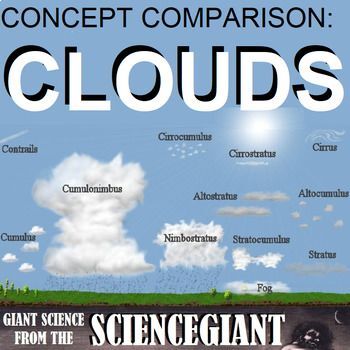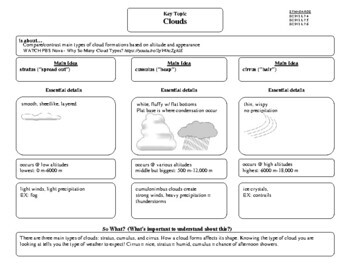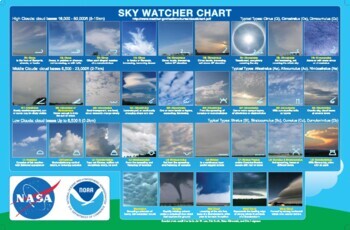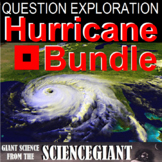Concept Comparison Frame: Types of Clouds
- PDF
Also included in
- Get ready for hurricane season! All of the materials I am including in this bundled Content Enhancement download are available as individual products sold separately on TpT in The ScienceGiant store. Below is a list of what Ts will receive. Please click on each link to receive a detailed descriptioPrice $18.90Original Price $27.00Save $8.10
Description
All clouds are made up of basically the same thing: water (droplets or crystals) that float in the sky. But all clouds look a bit different from one another. This concept comparison frame has Ss contrast some of the most common cloud types to spot in the sky, and helps them explain How Do Clouds Form?
Framing Routines are instructional methods that teachers can use to help a diverse student population understand a body of content information by carefully answering a critical question to arrive at a main idea answer. Students taught using the Content Enhancement routines earned higher total test scores than did students taught using the lecture-discussion method.
Personally, I use Content Enhancement Routines to figure out what I want to say and how I want to say it. It keeps my "Sage on the Stage" time limited to what fits onto 2-3 pages (about 45 minutes of directed class discussion).
This resource includes both the completed strategic instruction, and the student guide blanked except for vocabulary, scaffolding questions, and graphics already filled in. It includes worksheets and recommended video for review. There are two activities: a hands-on cloud mobile, and a whole class line-up formation.
These Concept Enhancement Routines are classroom tested to help students with the following Florida Next Generation Sunshine State Standards in Science:
- SC.2.E.7.5 State the importance of preparing for severe weather, lightning, and other weather related events.
- SC.5.E.7.3 Recognize how air temperature, barometric pressure, humidity, wind speed and direction, and precipitation determine the weather in a particular place and time.
- SC.5.E.7.4 Distinguish among the various forms of precipitation (rain, snow, sleet, and hail), making connections to the weather in a particular place and time.
- SC.6.E.7.2 Investigate and apply how the cycling of water between the atmosphere and hydrosphere has an effect on weather patterns and climate.
- SC.6.E.7.8 Describe ways human beings protect themselves from hazardous weather.
- SC.912.E.7.5 Predict future weather conditions based on present observations and conceptual models and recognize limitations and uncertainties of such predictions.
- SC.912.E.7.9 Relate the formation of severe weather to the various physical factors.
Related Resources
#StayGiant and stay up on my new resources and STEM news. Look for the green ★ star near the top of any page within my store and click "FOLLOW". Or follow @TheScienceGiant Twitter. Stand on The Shoulders of Giants, and together we'll see further, inspire students, and enlighten inquisitive minds!






